Leadership and People Management: J&J Furnishing Ltd Case Analysis
VerifiedAdded on 2020/05/08
|6
|1190
|173
Report
AI Summary
This report analyzes the case study of J&J Furnishing Ltd., identifying transformational leadership as the most appropriate style for achieving the organization's goals. The report details the characteristics of a transformational leader and justifies its use in creating a vision, motivating the workforce, and building trust. It outlines key tools and techniques, including incorporating the triple bottom line and implementing information technology processes to enhance efficiency and brand image. The report also discusses the five types of power, emphasizing the importance of expert and reward power in motivating the workforce and managing projects effectively. Finally, it addresses potential challenges such as project delays, misalignment, and resource conflicts, and suggests measures to mitigate these issues, providing a comprehensive analysis of leadership and organizational behavior within the context of the case study.
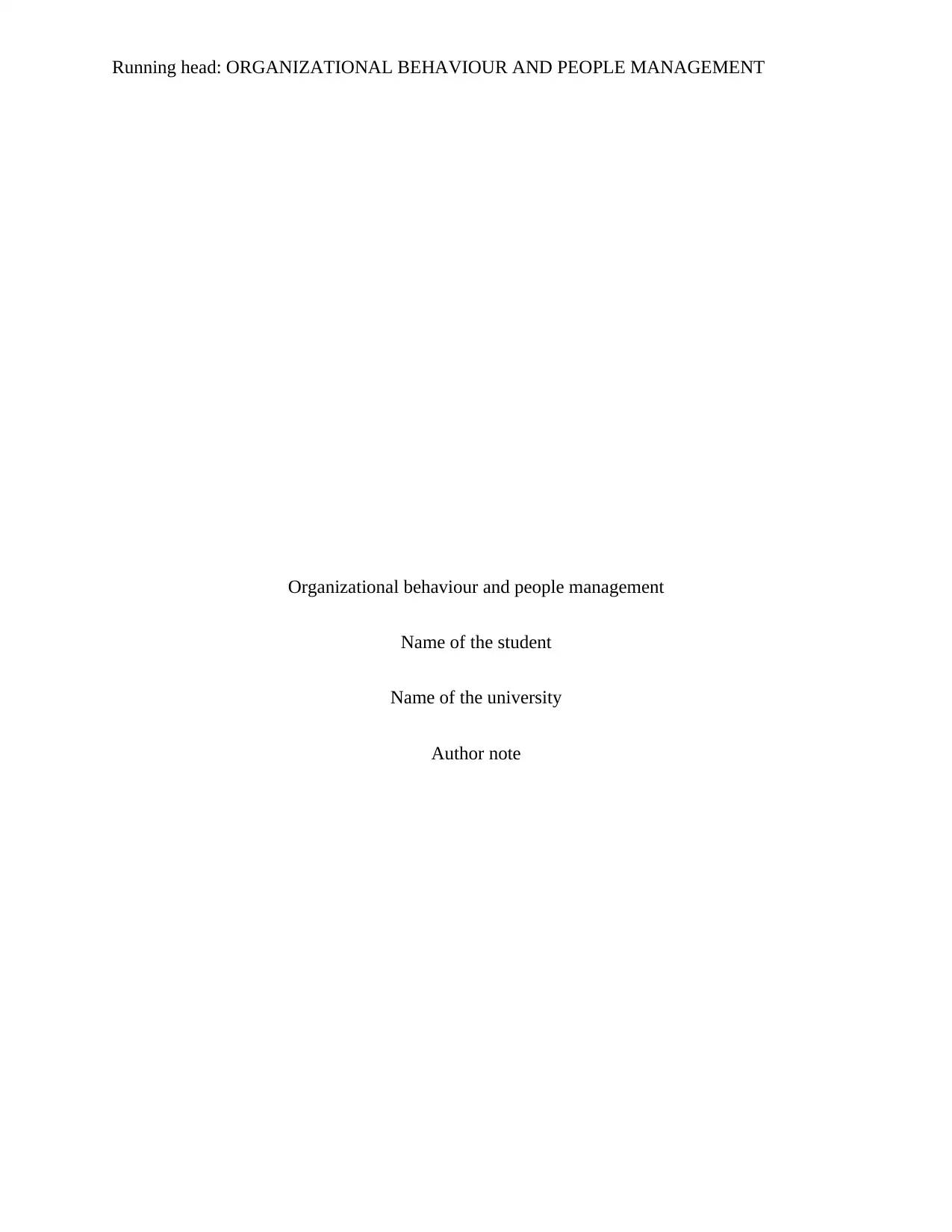
Running head: ORGANIZATIONAL BEHAVIOUR AND PEOPLE MANAGEMENT
Organizational behaviour and people management
Name of the student
Name of the university
Author note
Organizational behaviour and people management
Name of the student
Name of the university
Author note
Paraphrase This Document
Need a fresh take? Get an instant paraphrase of this document with our AI Paraphraser
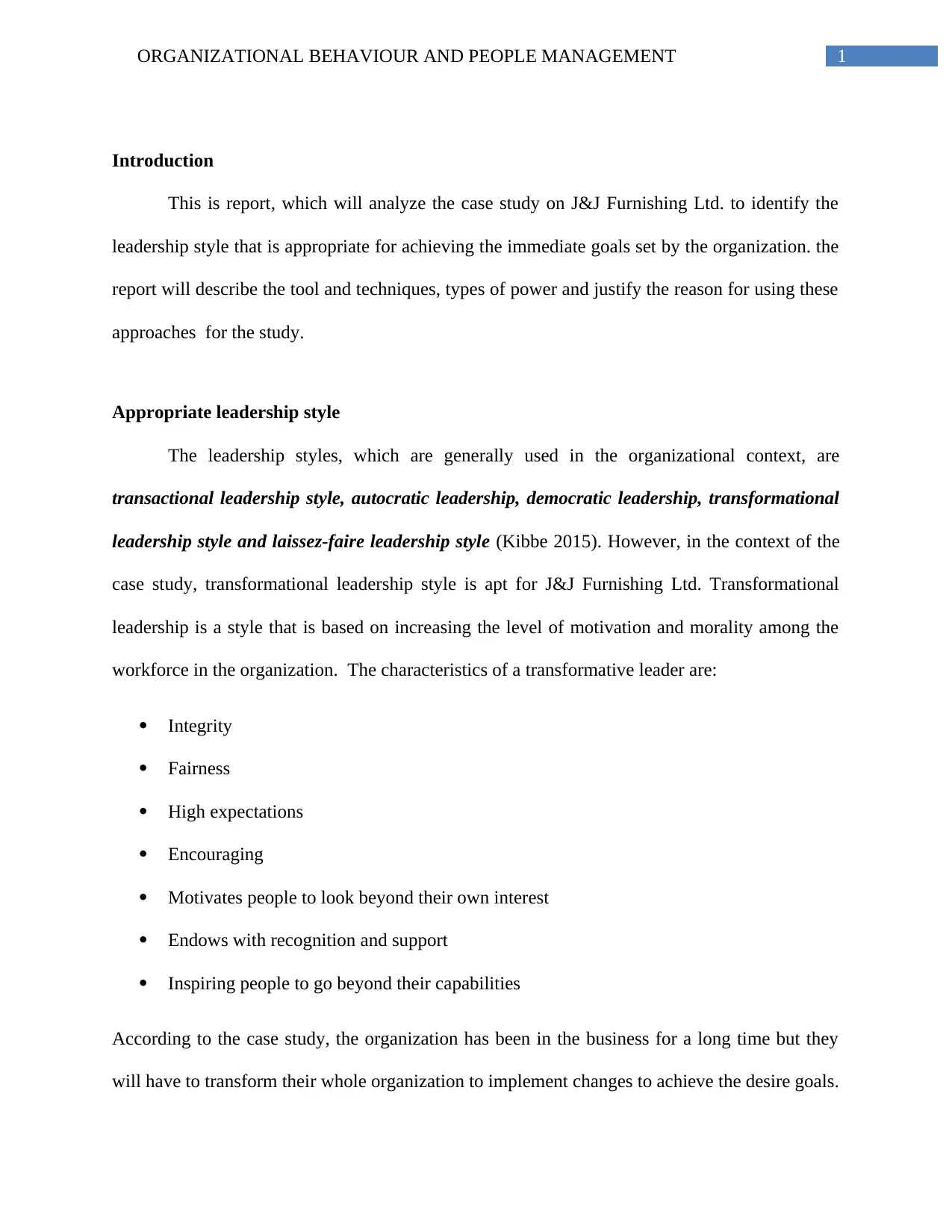
1ORGANIZATIONAL BEHAVIOUR AND PEOPLE MANAGEMENT
Introduction
This is report, which will analyze the case study on J&J Furnishing Ltd. to identify the
leadership style that is appropriate for achieving the immediate goals set by the organization. the
report will describe the tool and techniques, types of power and justify the reason for using these
approaches for the study.
Appropriate leadership style
The leadership styles, which are generally used in the organizational context, are
transactional leadership style, autocratic leadership, democratic leadership, transformational
leadership style and laissez-faire leadership style (Kibbe 2015). However, in the context of the
case study, transformational leadership style is apt for J&J Furnishing Ltd. Transformational
leadership is a style that is based on increasing the level of motivation and morality among the
workforce in the organization. The characteristics of a transformative leader are:
Integrity
Fairness
High expectations
Encouraging
Motivates people to look beyond their own interest
Endows with recognition and support
Inspiring people to go beyond their capabilities
According to the case study, the organization has been in the business for a long time but they
will have to transform their whole organization to implement changes to achieve the desire goals.
Introduction
This is report, which will analyze the case study on J&J Furnishing Ltd. to identify the
leadership style that is appropriate for achieving the immediate goals set by the organization. the
report will describe the tool and techniques, types of power and justify the reason for using these
approaches for the study.
Appropriate leadership style
The leadership styles, which are generally used in the organizational context, are
transactional leadership style, autocratic leadership, democratic leadership, transformational
leadership style and laissez-faire leadership style (Kibbe 2015). However, in the context of the
case study, transformational leadership style is apt for J&J Furnishing Ltd. Transformational
leadership is a style that is based on increasing the level of motivation and morality among the
workforce in the organization. The characteristics of a transformative leader are:
Integrity
Fairness
High expectations
Encouraging
Motivates people to look beyond their own interest
Endows with recognition and support
Inspiring people to go beyond their capabilities
According to the case study, the organization has been in the business for a long time but they
will have to transform their whole organization to implement changes to achieve the desire goals.
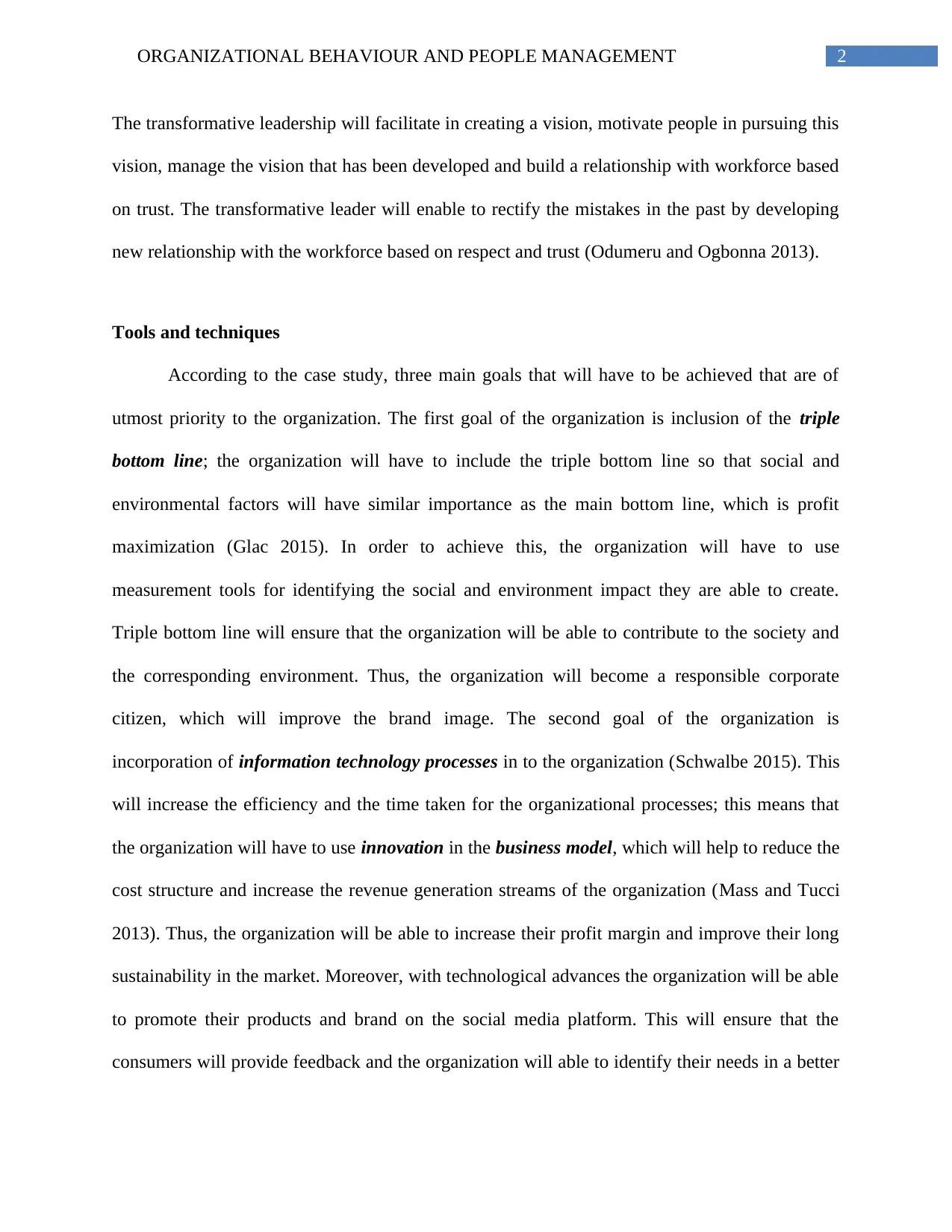
2ORGANIZATIONAL BEHAVIOUR AND PEOPLE MANAGEMENT
The transformative leadership will facilitate in creating a vision, motivate people in pursuing this
vision, manage the vision that has been developed and build a relationship with workforce based
on trust. The transformative leader will enable to rectify the mistakes in the past by developing
new relationship with the workforce based on respect and trust (Odumeru and Ogbonna 2013).
Tools and techniques
According to the case study, three main goals that will have to be achieved that are of
utmost priority to the organization. The first goal of the organization is inclusion of the triple
bottom line; the organization will have to include the triple bottom line so that social and
environmental factors will have similar importance as the main bottom line, which is profit
maximization (Glac 2015). In order to achieve this, the organization will have to use
measurement tools for identifying the social and environment impact they are able to create.
Triple bottom line will ensure that the organization will be able to contribute to the society and
the corresponding environment. Thus, the organization will become a responsible corporate
citizen, which will improve the brand image. The second goal of the organization is
incorporation of information technology processes in to the organization (Schwalbe 2015). This
will increase the efficiency and the time taken for the organizational processes; this means that
the organization will have to use innovation in the business model, which will help to reduce the
cost structure and increase the revenue generation streams of the organization (Mass and Tucci
2013). Thus, the organization will be able to increase their profit margin and improve their long
sustainability in the market. Moreover, with technological advances the organization will be able
to promote their products and brand on the social media platform. This will ensure that the
consumers will provide feedback and the organization will able to identify their needs in a better
The transformative leadership will facilitate in creating a vision, motivate people in pursuing this
vision, manage the vision that has been developed and build a relationship with workforce based
on trust. The transformative leader will enable to rectify the mistakes in the past by developing
new relationship with the workforce based on respect and trust (Odumeru and Ogbonna 2013).
Tools and techniques
According to the case study, three main goals that will have to be achieved that are of
utmost priority to the organization. The first goal of the organization is inclusion of the triple
bottom line; the organization will have to include the triple bottom line so that social and
environmental factors will have similar importance as the main bottom line, which is profit
maximization (Glac 2015). In order to achieve this, the organization will have to use
measurement tools for identifying the social and environment impact they are able to create.
Triple bottom line will ensure that the organization will be able to contribute to the society and
the corresponding environment. Thus, the organization will become a responsible corporate
citizen, which will improve the brand image. The second goal of the organization is
incorporation of information technology processes in to the organization (Schwalbe 2015). This
will increase the efficiency and the time taken for the organizational processes; this means that
the organization will have to use innovation in the business model, which will help to reduce the
cost structure and increase the revenue generation streams of the organization (Mass and Tucci
2013). Thus, the organization will be able to increase their profit margin and improve their long
sustainability in the market. Moreover, with technological advances the organization will be able
to promote their products and brand on the social media platform. This will ensure that the
consumers will provide feedback and the organization will able to identify their needs in a better
⊘ This is a preview!⊘
Do you want full access?
Subscribe today to unlock all pages.

Trusted by 1+ million students worldwide
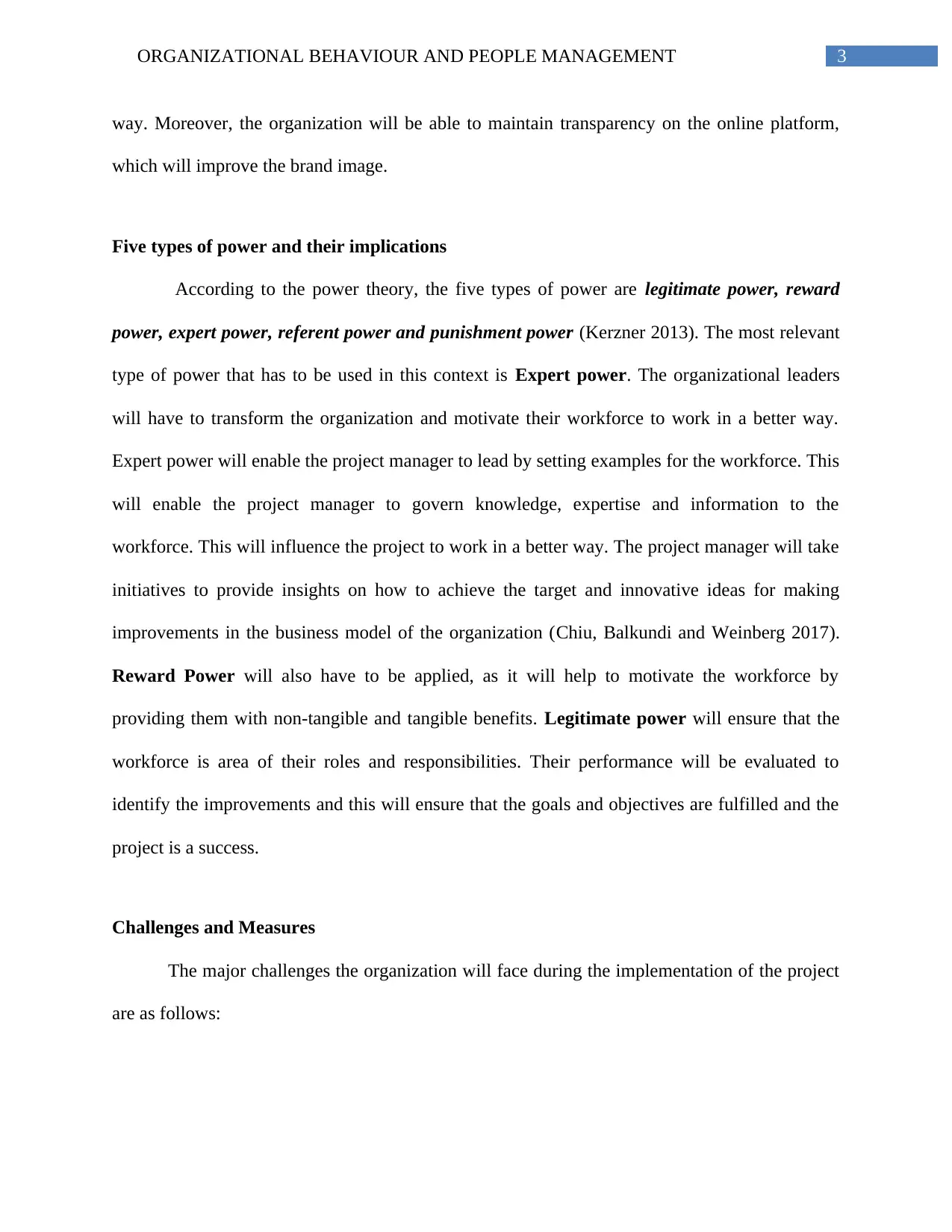
3ORGANIZATIONAL BEHAVIOUR AND PEOPLE MANAGEMENT
way. Moreover, the organization will be able to maintain transparency on the online platform,
which will improve the brand image.
Five types of power and their implications
According to the power theory, the five types of power are legitimate power, reward
power, expert power, referent power and punishment power (Kerzner 2013). The most relevant
type of power that has to be used in this context is Expert power. The organizational leaders
will have to transform the organization and motivate their workforce to work in a better way.
Expert power will enable the project manager to lead by setting examples for the workforce. This
will enable the project manager to govern knowledge, expertise and information to the
workforce. This will influence the project to work in a better way. The project manager will take
initiatives to provide insights on how to achieve the target and innovative ideas for making
improvements in the business model of the organization (Chiu, Balkundi and Weinberg 2017).
Reward Power will also have to be applied, as it will help to motivate the workforce by
providing them with non-tangible and tangible benefits. Legitimate power will ensure that the
workforce is area of their roles and responsibilities. Their performance will be evaluated to
identify the improvements and this will ensure that the goals and objectives are fulfilled and the
project is a success.
Challenges and Measures
The major challenges the organization will face during the implementation of the project
are as follows:
way. Moreover, the organization will be able to maintain transparency on the online platform,
which will improve the brand image.
Five types of power and their implications
According to the power theory, the five types of power are legitimate power, reward
power, expert power, referent power and punishment power (Kerzner 2013). The most relevant
type of power that has to be used in this context is Expert power. The organizational leaders
will have to transform the organization and motivate their workforce to work in a better way.
Expert power will enable the project manager to lead by setting examples for the workforce. This
will enable the project manager to govern knowledge, expertise and information to the
workforce. This will influence the project to work in a better way. The project manager will take
initiatives to provide insights on how to achieve the target and innovative ideas for making
improvements in the business model of the organization (Chiu, Balkundi and Weinberg 2017).
Reward Power will also have to be applied, as it will help to motivate the workforce by
providing them with non-tangible and tangible benefits. Legitimate power will ensure that the
workforce is area of their roles and responsibilities. Their performance will be evaluated to
identify the improvements and this will ensure that the goals and objectives are fulfilled and the
project is a success.
Challenges and Measures
The major challenges the organization will face during the implementation of the project
are as follows:
Paraphrase This Document
Need a fresh take? Get an instant paraphrase of this document with our AI Paraphraser
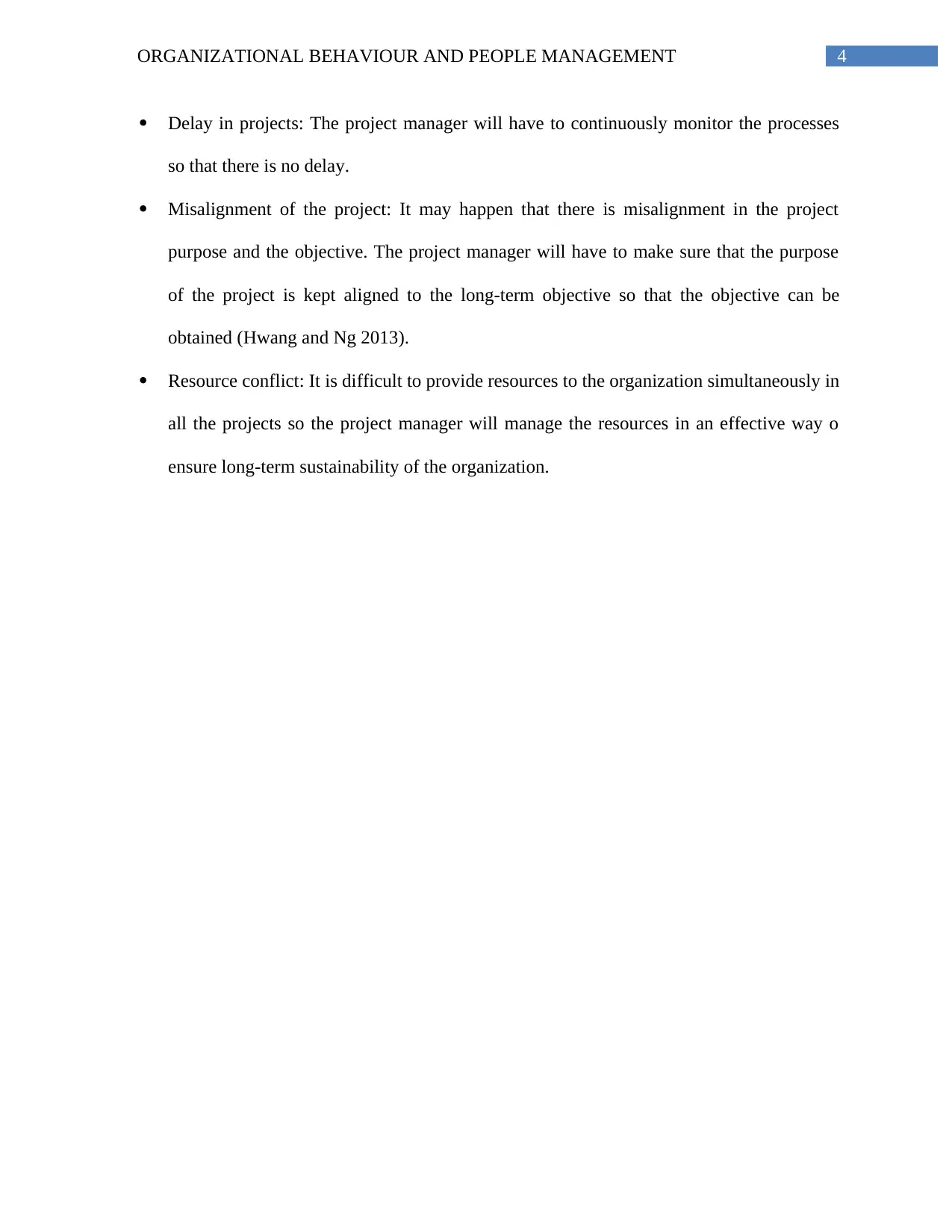
4ORGANIZATIONAL BEHAVIOUR AND PEOPLE MANAGEMENT
Delay in projects: The project manager will have to continuously monitor the processes
so that there is no delay.
Misalignment of the project: It may happen that there is misalignment in the project
purpose and the objective. The project manager will have to make sure that the purpose
of the project is kept aligned to the long-term objective so that the objective can be
obtained (Hwang and Ng 2013).
Resource conflict: It is difficult to provide resources to the organization simultaneously in
all the projects so the project manager will manage the resources in an effective way o
ensure long-term sustainability of the organization.
Delay in projects: The project manager will have to continuously monitor the processes
so that there is no delay.
Misalignment of the project: It may happen that there is misalignment in the project
purpose and the objective. The project manager will have to make sure that the purpose
of the project is kept aligned to the long-term objective so that the objective can be
obtained (Hwang and Ng 2013).
Resource conflict: It is difficult to provide resources to the organization simultaneously in
all the projects so the project manager will manage the resources in an effective way o
ensure long-term sustainability of the organization.
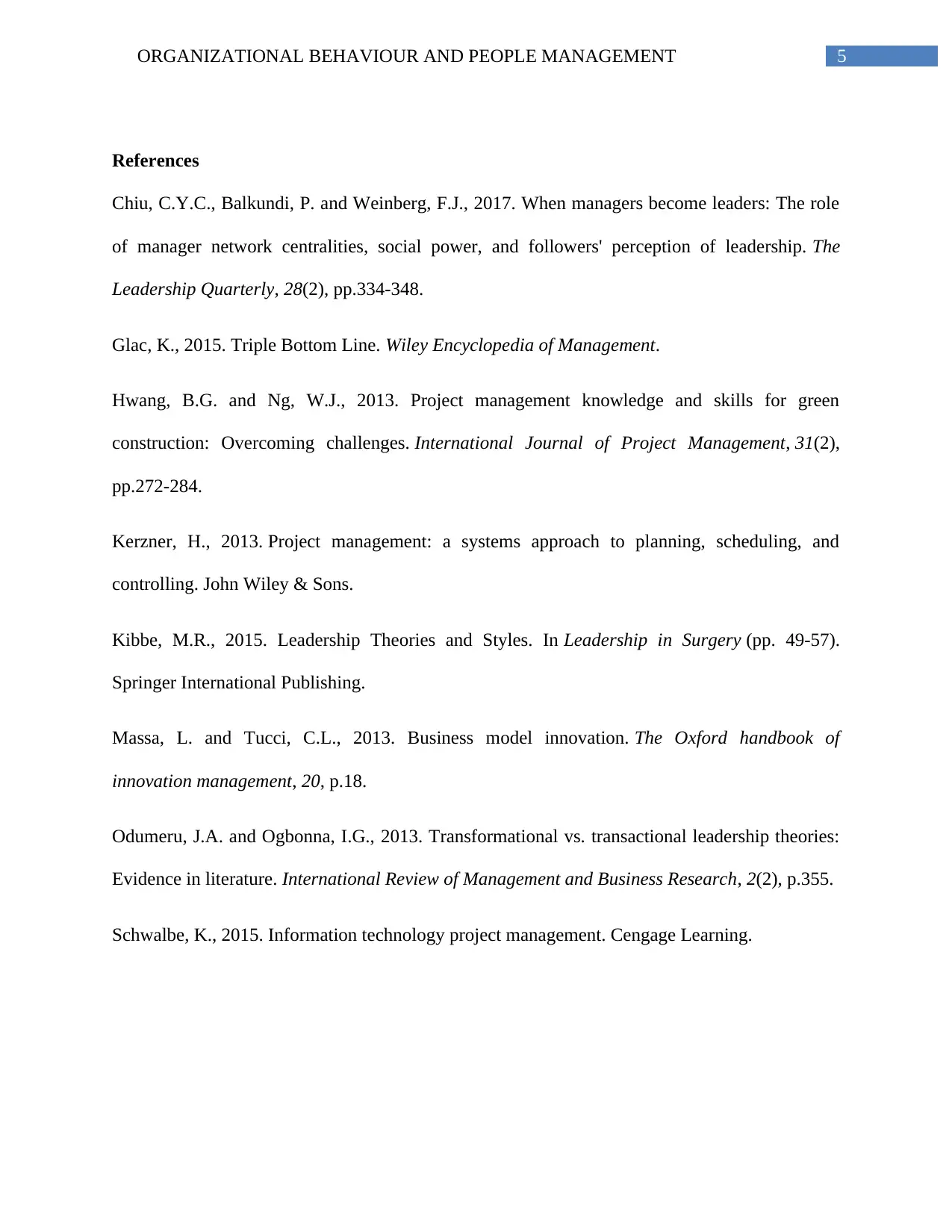
5ORGANIZATIONAL BEHAVIOUR AND PEOPLE MANAGEMENT
References
Chiu, C.Y.C., Balkundi, P. and Weinberg, F.J., 2017. When managers become leaders: The role
of manager network centralities, social power, and followers' perception of leadership. The
Leadership Quarterly, 28(2), pp.334-348.
Glac, K., 2015. Triple Bottom Line. Wiley Encyclopedia of Management.
Hwang, B.G. and Ng, W.J., 2013. Project management knowledge and skills for green
construction: Overcoming challenges. International Journal of Project Management, 31(2),
pp.272-284.
Kerzner, H., 2013. Project management: a systems approach to planning, scheduling, and
controlling. John Wiley & Sons.
Kibbe, M.R., 2015. Leadership Theories and Styles. In Leadership in Surgery (pp. 49-57).
Springer International Publishing.
Massa, L. and Tucci, C.L., 2013. Business model innovation. The Oxford handbook of
innovation management, 20, p.18.
Odumeru, J.A. and Ogbonna, I.G., 2013. Transformational vs. transactional leadership theories:
Evidence in literature. International Review of Management and Business Research, 2(2), p.355.
Schwalbe, K., 2015. Information technology project management. Cengage Learning.
References
Chiu, C.Y.C., Balkundi, P. and Weinberg, F.J., 2017. When managers become leaders: The role
of manager network centralities, social power, and followers' perception of leadership. The
Leadership Quarterly, 28(2), pp.334-348.
Glac, K., 2015. Triple Bottom Line. Wiley Encyclopedia of Management.
Hwang, B.G. and Ng, W.J., 2013. Project management knowledge and skills for green
construction: Overcoming challenges. International Journal of Project Management, 31(2),
pp.272-284.
Kerzner, H., 2013. Project management: a systems approach to planning, scheduling, and
controlling. John Wiley & Sons.
Kibbe, M.R., 2015. Leadership Theories and Styles. In Leadership in Surgery (pp. 49-57).
Springer International Publishing.
Massa, L. and Tucci, C.L., 2013. Business model innovation. The Oxford handbook of
innovation management, 20, p.18.
Odumeru, J.A. and Ogbonna, I.G., 2013. Transformational vs. transactional leadership theories:
Evidence in literature. International Review of Management and Business Research, 2(2), p.355.
Schwalbe, K., 2015. Information technology project management. Cengage Learning.
⊘ This is a preview!⊘
Do you want full access?
Subscribe today to unlock all pages.

Trusted by 1+ million students worldwide
1 out of 6
Related Documents
Your All-in-One AI-Powered Toolkit for Academic Success.
+13062052269
info@desklib.com
Available 24*7 on WhatsApp / Email
![[object Object]](/_next/static/media/star-bottom.7253800d.svg)
Unlock your academic potential
Copyright © 2020–2025 A2Z Services. All Rights Reserved. Developed and managed by ZUCOL.




